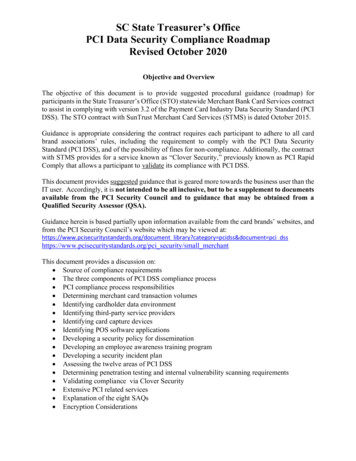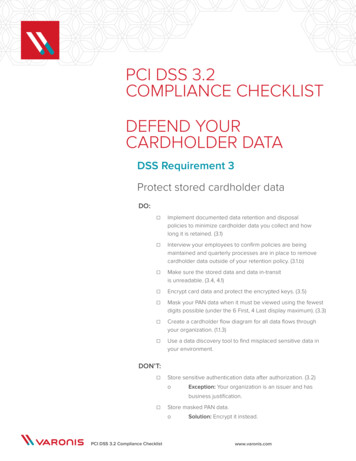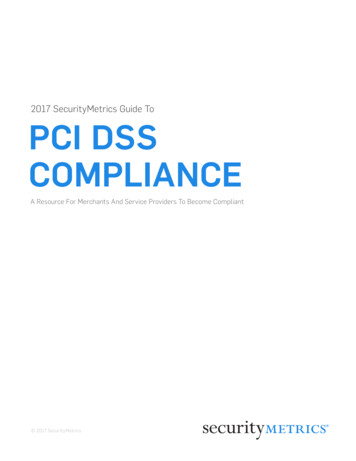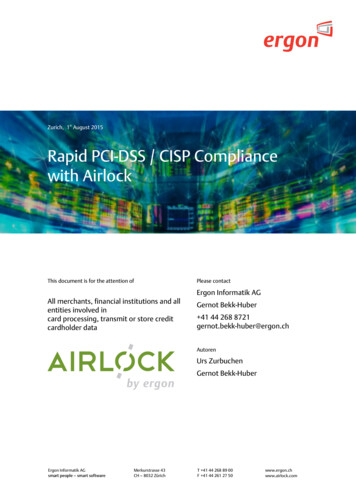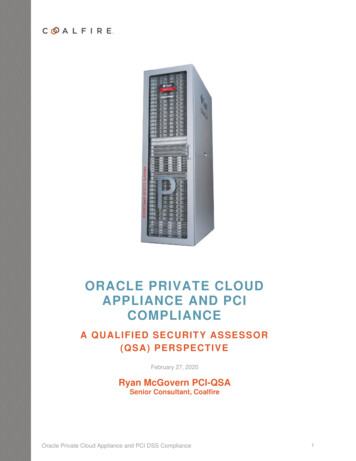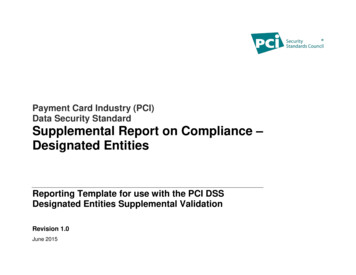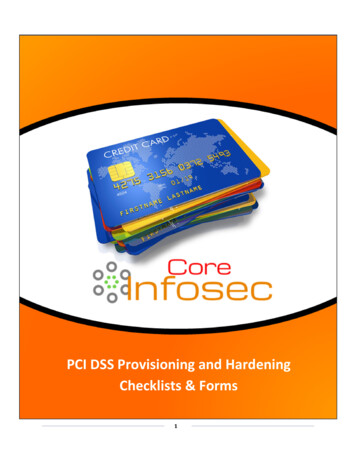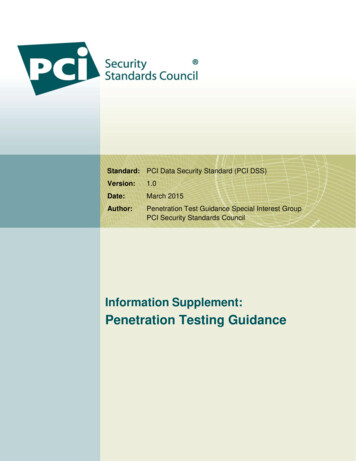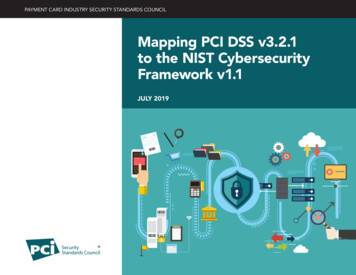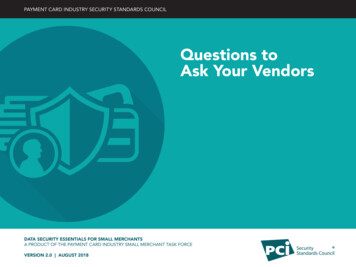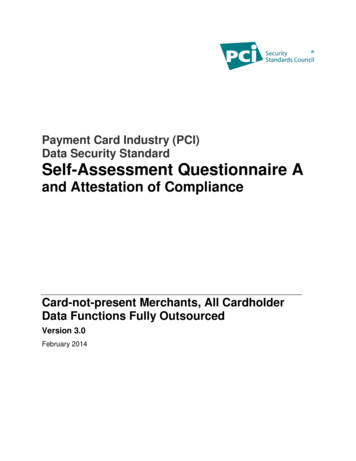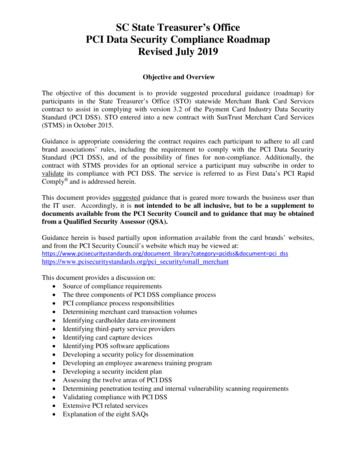
Transcription
SC State Treasurer’s OfficePCI Data Security Compliance RoadmapRevised July 2019Objective and OverviewThe objective of this document is to provide suggested procedural guidance (roadmap) forparticipants in the State Treasurer’s Office (STO) statewide Merchant Bank Card Servicescontract to assist in complying with version 3.2 of the Payment Card Industry Data SecurityStandard (PCI DSS). STO entered into a new contract with SunTrust Merchant Card Services(STMS) in October 2015.Guidance is appropriate considering the contract requires each participant to adhere to all cardbrand associations’ rules, including the requirement to comply with the PCI Data SecurityStandard (PCI DSS), and of the possibility of fines for non-compliance. Additionally, thecontract with STMS provides for an optional service a participant may subscribe in order tovalidate its compliance with PCI DSS. The service is referred to as First Data’s PCI RapidComply and is addressed herein.This document provides suggested guidance that is geared more towards the business user thanthe IT user. Accordingly, it is not intended to be all inclusive, but to be a supplement todocuments available from the PCI Security Council and to guidance that may be obtainedfrom a Qualified Security Assessor (QSA).Guidance herein is based partially upon information available from the card brands’ websites,and from the PCI Security Council’s website which may be viewed at:https://www.pcisecuritystandards.org/document library?category pcidss&document pci dsshttps://www.pcisecuritystandards.org/pci security/small merchantThis document provides a discussion on: Source of compliance requirements The three components of PCI DSS compliance process PCI compliance process responsibilities Determining merchant card transaction volumes Identifying cardholder data environment Identifying third-party service providers Identifying card capture devices Identifying POS software applications Developing a security policy for dissemination Developing an employee awareness training program Developing a security incident plan Assessing the twelve areas of PCI DSS Determining penetration testing and internal vulnerability scanning requirements Validating compliance with PCI DSS Extensive PCI related services Explanation of the eight SAQs
PCI Compliance RoadmapCompletion of many of the tasks listed above may be necessary in order to successfully answerthe Self-Assessment Questionnaire (SAQ) that the participant is be required to prepare, eitherthrough PCI Rapid Comply or otherwise.1. Source of Compliance RequirementsCompliance with the PCI DSS is a contractual requirement of the merchant card servicesprovider (SunTrust Merchant Services, LLC) and the acquirer bank (SunTrust Bank, N.A.),which jointly utilizes First Data as the processor. The standard, which is subject to revisions,is promulgated by the PCI Data Security Council.2. The Three Components of PCI DSS Compliance ProcessThe PCI compliance process involves three components: Compliance – Performing required tasks and maintaining systems appropriately,which must be done throughout the year (not just an annual event). Validation – Preparing an annual Self-Assessment Questionnaire (SAQ) andperforming any required external vulnerability scanning on a quarterly basis, ifapplicable. Attestation – Reporting the validation of compliance whenever requested by eitherSTMS or the card brands. Attestation can involve the completion of an “Attestationof Compliance” (AOC) and may require documentation supporting the validationtasks (providing copy of SAQ and results of latest vulnerability scan).3. PCI Compliance Process ResponsibilitiesSince merchant cards processing is associated with IT systems, financial systems, andbusiness users, it is imperative that there be a coordination of all parties and activitiesinvolved in the validation process. PCI DSS compliance is a result of management’sdecision to accept merchant cards, and as such, this decision may require extensive supportfrom IT. Thus, PCI DSS compliance is primarily deemed to be a business problem with anIT solution.Because many of the PCI compliance and validation requirements involve IT solutions, inthe past some participants have tended to rely upon their IT departments to assume the entireresponsibility of compliance. However, many of the PCI compliance tasks involve thebusiness users as well. Therefore, the compliance component of the process is a jointresponsibility of both the business and IT sectors. One of the best practices for ensuring acoordination of the interests and responsibilities of both sectors is to establish a PCIOversight Committee. The creation of a committee charter is recommended.The other two components of the process (validation and attestation) are normally theresponsibility of someone in the business sector. It is the business sector that is responsiblefor adhering to accounting, administrative, and procurement policies. Additionally, it isSTO PCI Data Security Compliance Roadmap (Revised July 2019)Page 2
PCI Compliance Roadmapsomeone in the business sector that is involved in the execution of the contractualarrangement with the merchant card provider and will be addressing any issues that mayresult from non-compliance or breaches (e.g., inquiries from the card brands or lawenforcement agencies).4.Determining Merchant Card Transaction VolumesThe card brands, not the PCI Security Council, determine what merchants must do in orderto validate their PCI compliance. The determination is based upon annual transactionvolumes. There are four established levels under which a merchant will fall: 1, 2, 3, or 4.A) Level 1 and 2 merchantsLevel 1 merchants are required to have an annual onsite security audit performed by aqualified security assessor (QSA). Level 2 merchants are required to have either an annualonsite security audit performed by a qualified security assessor (QSA) or a passing SelfAssessment Questionnaire (SAQ) along with a corresponding Attestation of Compliance(AOC). If a PCI Approved Qualified Security Assessor (QSA) is engaged to assist with thepreparation of the merchant’s SAQ, the QSA must come on-site.As an alternative, Level 2 merchants may choose to complete a Self-AssessmentQuestionnaire using an internal security auditor (ISA). In order to use an internal auditor,the merchant must ensure that the primary internal auditor staff person engaged in validatingPCI DSS compliance attends PCI SSC ISA training and passes the associated accreditationprogram annually.In addition, level 1 and 2 merchants must undergo external vulnerability scanning, ifapplicable (utilize capture systems involving external/public facing IP addresses).B) Level 3 and 4 merchantsLevel 3 and 4 merchants must complete an annual self-assessment questionnaire (SAQ) andundergo external vulnerability scanning, if applicable. On-site security audits are notnecessarily required of level 3 and 4 merchants.C) Transaction volumesThe transaction volume used in determining the appropriate levels is that of the “doingbusiness as” (DBA) entity, which in most cases is the participant’s single chain-chain level,not individual merchant number levels or departments. Under the State’s master contract,STMS/First Data monitor’s each participant’s transaction total volume and e-commercevolume and makes the official determination of the merchant’s PCI level.A participant can ascertain its annual transaction volume, for each card brand, through allpayment channels, to determine its assigned merchant level. Each brand specifiescalculating its own card transaction volume only to determine the assigned level. However,the brand with the lower volume defers to the brand with the higher volume as the level thatSTO PCI Data Security Compliance Roadmap (Revised July 2019)Page 3
PCI Compliance Roadmapis to be assigned. For example, most participants will have more Visa transactions thanMasterCard transactions. Those participants will therefore use the Visa transaction volumeto determine its assigned level. Total transaction volumes across all brands are not to beconsidered.The following exercise will assist in determining which level you are likely considered.Transaction volumes can be determined through the merchant card processor’s onlinereporting tool (e.g., ClientLine) and from reports provided by any gateway services utilized.E-commerceAnnual Merchant Card Transactions VolumeVisa TransactionsMasterCard TransactionsNon eTotalENon eTotalcommercecommercecommerceThe first transaction volume to consider is the e-commerce volume for the higher brand. Ifthe e-commerce transaction volume is between 20,000 and 1 million (regardless of thenumber of total transactions), the participant is considered a level 3 merchant.The second transaction volume to consider is the total number of transactions for the higherbrand. If the participant is not considered a level 3 merchant by virtue of having at least20,000 e-commerce transactions, and the total number of transactions is less than 1 milliontransactions, the participant is considered a level 4 merchant.The threshold for moving from level 3 to level 2 is one million total transactions of thehigher card brand (e.g., Visa). From the perspective of validation requirements (i.e., annualSAQ and quarterly external vulnerability scanning), there is no difference between being alevel 3 and level 4 merchant.5.Identifying the Cardholder Data EnvironmentThe steps to follow to validate PCI compliance, and the complexity of complying, willdepend upon the cardholder data environment (CDE). The scope of PCI pertains to anysystem that either, “processes,” “transmits,” or “stores” cardholder data. This could be inhouse systems or systems outsourced to a service provider. Therefore, it is necessary toperform a complete inventory of where and how merchant cards are accepted for payment.The State’s merchant card provider (STMS) has assigned each participant a “chain-chainnumber.” Under the chain-chain, there could be a single or multiple “merchant IDs” (MIDs).There is generally a unique MID for each business unit or location. The participant’s chainchain number and associated MIDs can be viewed through STMS’s reporting tool(ClientLine).In the case of an outsourced arrangement with a service provider, the provider is consideredpart of the CDE. The owner of the merchant number is considered the merchant of record(MOR), which in most cases is the participant.However, even if the service provider is the MOR, the entity making the sale or providing theservice is consider the “merchant” under the PCI-DSS and is responsible for complying withSTO PCI Data Security Compliance Roadmap (Revised July 2019)Page 4
PCI Compliance Roadmapcertain elements of the standard. The PCI Security Council’s definition of a merchant is:“For the purposes of the PCI DSS, a merchant is defined as any entity that accepts paymentcards bearing the logos of any of the five members of PCI SSC (American Express, Discover,JCB, MasterCard or Visa) as payment for goods and/or services.”A) E-commerce Versus Non e-commerceAt the highest level, the two main categories of cardholder data environment (CDE) are: ecommerce and non-e-commerce.Cardholder Data Environment (CDE) for the Participant’s ChainNon e-commerce Merchant NumbersE-commerce Merchant Numbers(Face-to-face and MOTO capture)(Website O Mail Order Telephone Order)The appropriate Self-Assessment Questionnaire (SAQ) selected will be based upon the CDEand capture methods. (See discussion on Self-Assessment Questionnaires - page 13 below.)B) External Facing IP AddressesMerchant numbers that are associated with external (public) facing IP addresses must beidentified, as the IP addresses are subject to undergoing external vulnerability scanning.Firewall and network segmentation configurations must be taken into consideration whendetermining which IP addresses are in scope.Servers for capture solutions connected via the internet, including VOIP and PCs being usedas a virtual terminal, should be included. In most cases, web solutions that involve an “URLredirect” are not subject to external vulnerability scanning. However, connected web serversfacilitating redirects are in PCI scope for other PCI requirements (e.g., anti-virus updates,etc.). POS terminals connected via an analog telephone line should not be included.Merchant Numbers Associated with External-Facing IP AddressesIn-House HostedWebVirtual TerminalPOS TerminalConnected to IPPOS SoftwareConnected to IP6. Identifying Third-Party Service ProvidersOutsourcing merchant card processing to third-party service providers can limit the scope ofPCI compliance, but not eliminate it. The PCI Security Council defines a service provider asSTO PCI Data Security Compliance Roadmap (Revised July 2019)Page 5
PCI Compliance Roadmapany “business entity that is not a payment brand, directly involved in the processing, storage,or transmission of cardholder data. This also includes companies that provide services thatcontrol or could impact the security of cardholder data.” A service provider would thereforeinclude any company providing a gateway service, a data storage service, or a web hostingservice. The merchant’s responsibilities pertaining to service providers are identified insections 12.8 and 12.9 of the PCI DSS.The merchant’s responsibilities regarding a service provider are to: 1) maintain a list ofservice providers; 2) ensure that the provider is compliant by performing a due diligenceevaluation prior to engagement; 3) ensure the provider’s continued status of compliance byhaving established an ongoing monitoring process; and 4) have in place a written agreementthat identifies the provider’s responsibilities regarding compliance roles.Section 12.9 requires the service provider to acknowledge in writing its responsibility forPCI. A “matrix of responsibilities” document is required, to identify (clarify) theresponsibilities of each the participant and the service provider (Section 12.8.5).Participants utilizing South Carolina Interactive, LLC (SCI), the State’s web portal provider(SC.Gov), is considered a service provider.A) Levels of Service ProvidersThe card brands classify service providers according to two levels, just as merchants areclassified into four levels. While both levels are required to complete a SAQ and to undergoexternal vulnerability scanning, only level 1 service providers are required to undergo anonsite security assessment by a qualified security assessor (QSA). The participant shouldidentify which level each of its service providers is classified.Participant’s Third Party Service ProvidersLevel 1Level 2Processes more than 300,000 transactionsannuallyProcesses less than 300,000 transactionsannuallyService provider is required to undergo an Service provider is not required to undergoonsite security assessment by a QSAan onsite security assessment by a QSAThe participant should determine who within the agency/university has the responsibility ofperforming the due diligence and monitoring process, and the frequency. To assist merchantsin their due diligence process of determining and monitoring PCI compliance of a serviceprovider, Visa and MasterCard both maintain a global registry of services providers that haveregistered with them. The registries can be viewed at: http://www.visa.com/splisting/ to-know.html.STO PCI Data Security Compliance Roadmap (Revised July 2019)Page 6
PCI Compliance RoadmapA level 2 service provider may not necessarily be registered with Visa, in which case themerchant should secure evidence of compliance directly from the provider. If the serviceprovider is a Level 1 service provider, the provider should be able to furnish evidence of its“Report on Compliance” (ROC).B) Written Agreement with Service ProvidersThe participant should inspect its engagement contract with each service provider to ensure itcontains the appropriate language to comply with section 12.8 and 12.9 of the standard. If thecontract does not (e.g., for older contracts), it is recommended that an addendum be preparedand executed to incorporate the new requirement, including a “matrix of responsibilities.”Although the standard does not require the written agreement to specify the liability of theservice provider in the event of a security breach, it is best practice to address the issue. Thelack of specificity of liability in the case of a security breach could leave the participant atrisk regarding the potential paying of fines assessed by the card brands.C) Participant Functioning as a Service ProviderThere may be cases where the participant may possibly be deemed to be functioning as aservice provider. This could be the case where a third-party vendor utilizes the participant’snetwork to process merchant card transactions. Examples of such entities could include anoutsourced food service vendor (e.g., Aramark), occasional entertainers (e.g., HarlemGlobetrotters), or a legally separate entity but considered a component of the participant(e.g., certain bookstore arrangements). It is possible for such arrangements to be structuredsuch that the participant is only contractually agreeing to provide the entity “web access onlyservice,” thereby limiting the participant’s PCI exposure.D) Internal Service ProvidersConsultation with the State’s Division of Technology Office (DTO) may be necessary ifDTO hosts servers utilized by the participant. DTO could be considered an internal serviceprovider. Who manages the servers housed at DTO will determine who is responsible forhaving the servers undergo external vulnerability scanning, DTO or the participant.7. Identifying Card Capture DevicesCard data capture devices are of various types, including point of sale (POS) terminals witheither swipe devices or key pads. All terminals and devices must be PCI compliant.Section 9.9 of the standard addresses the physical protection of devices that capture paymentcard data. The purpose is to protect both tampering and substitution of the devices. While therequirement is mandatory for swipe devices, it is recommended for key devices, such ascomputer keyboards and POS keypads.The section requires the merchant to: 1) maintain an updated list of devices; 2) periodicallyinspect device surfaces to detect tampering or substitution; and 3) provide training toemployees to be aware of attempted tampering or substitution.STO PCI Data Security Compliance Roadmap (Revised July 2019)Page 7
PCI Compliance RoadmapThe participant should institute procedures to periodically physically inspect for fraudulentskimmers that may be attached to devices, and to check for fraudulent substitution bychecking the serial numbers of the devices. Training of employees should include therequirements to: 1) verify the identity of any third-party persons claiming to be repair ormaintenance personnel; and 2) be aware of suspicious behavior around devices (for example,attempts by unknown persons to unplug or open devices).The first step in complying with Section 9.9 is for the participant to prepare an inventory ofall devices, including those in both production and storage. (Effective July 1, 2015)Card Capture DevicesLocationDeviceSerial NumberAssociated MerchantNumber8. Identifying POS Software ApplicationsAssociated with PCI DSS is a separate standard referred to as the Payment Application DataSecurity Standard (PA-DSS) which requires a merchant to only use validated paymentapplications. A validated payment application is one that facilitates and does not prevent PCIDSS compliance.Examples of how an application may prevent PCI DSS compliance include: 1) leaving trackdata and/or equivalent data on the customer’s network after authorization; 2) requiringcustomers to disable features like an
through PCI Rapid Comply or otherwise. 1. Source of Compliance Requirements . Compliance with PCI DSS is a the contractual requirement of the merchant card services provider (SunTrust Merchant Services, LLC) and the acquirer bank (SunTrust Bank, N.A.), which jointly utilizes First Dat
